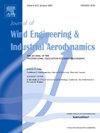Field measurement-based research on wind pressure interference effects of tracking photovoltaic arrays
IF 4.2
2区 工程技术
Q1 ENGINEERING, CIVIL
Journal of Wind Engineering and Industrial Aerodynamics
Pub Date : 2025-02-01
DOI:10.1016/j.jweia.2024.105971
引用次数: 0
Abstract
This paper investigates the wind interference effect on the rear row of photovoltaic modules as wind passes through the front row in a multi-row tracking photovoltaic array. Through field wind pressure measurements, we comprehensively evaluated the wind pressure interference effect under various tilt angle and wind direction angles, including variations in the wind pressure coefficient, wind force coefficient, central axis torque coefficient, column base moment coefficient, and fluctuating wind pressure power spectrum. The results indicate that when the wind direction angle is perpendicular to the panel width (L), the interference effect on the rear row is more significant, observed as a shading effect on the rear wind pressure coefficient, wind force coefficient, central axis torque coefficient, and column base moment coefficient. The interference effect gradually weakens as the wind direction angle increases/decreases; in the small tilt angle range (0° < β < 15°), the interference effect on the rear row is minimal. Additionally, under high tilt angle conditions, the third row experienced relatively higher wind forces compared to the second row. The interference effect of the fluctuating wind pressure power spectrum primarily manifests in the variation of vortex shedding frequency, significantly affecting the frequency peak of the rear components in the high-frequency band. The sensitivity of vortex shedding to wind direction and tilt angle adds complexity to the wind-resistant design of tracked PV arrays. This study offers valuable insights for designing tracking photovoltaic arrays to withstand wind forces.
基于实测的跟踪光伏阵列风压干扰效应研究
本文研究了多排跟踪光伏阵列中,风经过前排时对光伏组件后排的风干扰效应。通过现场风压测量,综合评价了不同倾斜角和风向角下的风压干扰效应,包括风压系数、风力系数、中心轴扭矩系数、柱基力矩系数和脉动风压功率谱的变化。结果表明:当风向角垂直于面板宽度(L)时,干扰对后排的影响更为显著,对后风压系数、风力系数、中轴扭矩系数和柱基弯矩系数产生遮阳效应;随着风向角的增大/减小,干扰效应逐渐减弱;在小倾角范围内(0°<;β& lt;15°),对后排的干扰影响最小。此外,在高倾斜角条件下,第三排比第二排经历了相对更大的风力。脉动风压功率谱的干扰效应主要表现在旋涡脱落频率的变化上,对高频波段后分量的频率峰值影响显著。旋涡脱落对风向和倾角的敏感性增加了履带式光伏阵列抗风设计的复杂性。这项研究为设计可承受风力的跟踪光伏阵列提供了有价值的见解。
本文章由计算机程序翻译,如有差异,请以英文原文为准。
求助全文
约1分钟内获得全文
求助全文
来源期刊
CiteScore
8.90
自引率
22.90%
发文量
306
审稿时长
4.4 months
期刊介绍:
The objective of the journal is to provide a means for the publication and interchange of information, on an international basis, on all those aspects of wind engineering that are included in the activities of the International Association for Wind Engineering http://www.iawe.org/. These are: social and economic impact of wind effects; wind characteristics and structure, local wind environments, wind loads and structural response, diffusion, pollutant dispersion and matter transport, wind effects on building heat loss and ventilation, wind effects on transport systems, aerodynamic aspects of wind energy generation, and codification of wind effects.
Papers on these subjects describing full-scale measurements, wind-tunnel simulation studies, computational or theoretical methods are published, as well as papers dealing with the development of techniques and apparatus for wind engineering experiments.

 求助内容:
求助内容: 应助结果提醒方式:
应助结果提醒方式:


